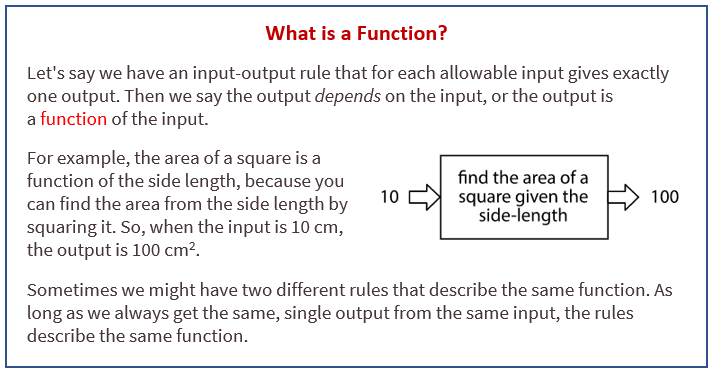Illustrative Mathematics Grade 8, Unit 5, Lesson 2: Introduction to Functions
Learning Targets:
- I know that a function is a rule with exactly one output for each allowable input.
- I know that if a rule has exactly one output for each allowable input, then the output depends on the input.
Related Pages
Illustrative Math
Grade 8
Lesson 2: Introduction to Functions
Let’s learn what a function is.
Illustrative Math Unit 8.5, Lesson 2 (printable worksheets)
Lesson 2 Summary
The following diagram shows that a function is a rule with exactly one output for each allowable input.

Lesson 2.1 Square Me
Here are some numbers in a list: 1, -3, -1/2, 3, 2, 1/4, 0.5
- How many different numbers are in the list?
- Make a new list containing the squares of all these numbers.
- How many different numbers are in the new list?
- Explain why the two lists do not have the same number of different numbers.
Lesson 2.2 You Know This, Do You Know That?
Say yes or no for each question. If yes, draw an input-output diagram. If no, give examples of two different outputs that are possible for the same input.
- A person is 5.5 feet tall. Do you know their height in inches?
- A number is 5. Do you know its square?
- The square of a number is 16. Do you know the number?
- A square has a perimeter of 12 cm. Do you know its area?
- A rectangle has an area of 16 cm2. Do you know its length?
- You are given a number. Do you know the number that is 1/5 as big?
- You are given a number. Do you know its reciprocal?
Lesson 2.3 Using Function Language
Here are the questions from the previous activity. For the ones you said yes to, write a statement like, “The height a rubber ball bounces to depends on the height it was dropped from” or “Bounce height is a function of drop height.” For all of the ones you said no to, write a statement like, “The day of the week does not determine the temperature that day” or “The temperature that day is not a function of the day of the week.”
- A person is 5.5 feet tall. Do you know their height in inches?
- A number is 5. Do you know its square?
- The square of a number is 16. Do you know the number?
- A square has a perimeter of 12 cm. Do you know its area?
- A rectangle has an area of 16 cm2. Do you know its length?
- You are given a number. Do you know the number that is 1/5 as big?
- You are given a number. Do you know its reciprocal?
Lesson 2.4 Same Function, Different Rule?
Which input-output rules could describe the same function (if any)? Be prepared to explain your reasoning.
Are you ready for more?
The phrase “is a function of” gets used in non-mathematical speech as well as mathematical speech in sentences like, “The range of foods you like is a function of your upbringing.” What is that sentence trying to convey? Is it the same use of the word “function” as the mathematical one?
Lesson 2 Practice Problems
- Here are several function rules. Calculate the output for each rule when you use -6 as the input.
- A group of students is timed while sprinting 100 meters. Each student’s speed can be found by dividing 100 m by their time. Is each statement true or false? Explain your reasoning.
a. Speed is a function of time.
b. Time is a function of distance.
c. Speed is a function of number of students racing.
d. Time is a function of speed. - Diego’s history teacher writes a test for the class with 26 questions. The test is worth 123 points and has two types of questions: multiple choice worth 3 points each, and essays worth 8 points each. How many essay questions are on the test? Explain or show your reasoning.
- These tables correspond to inputs and outputs. Which of these input and output tables could represent a function rule, and which ones could not? Explain or show your reasoning.
The Open Up Resources math curriculum is free to download from the Open Up Resources website and is also available from Illustrative Mathematics.
Try out our new and fun Fraction Concoction Game.
Add and subtract fractions to make exciting fraction concoctions following a recipe. There are four levels of difficulty: Easy, medium, hard and insane. Practice the basics of fraction addition and subtraction or challenge yourself with the insane level.

We welcome your feedback, comments and questions about this site or page. Please submit your feedback or enquiries via our Feedback page.